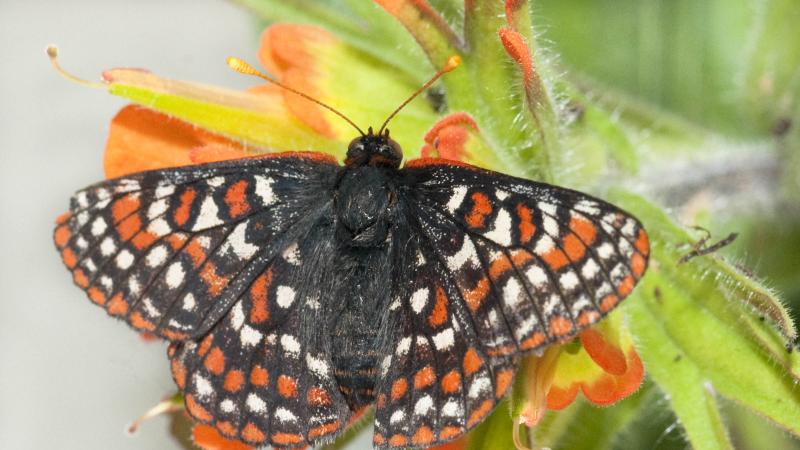Taylor's checkerspot butterfly

Section menu
Taylor’s checkerspot butterfly (Euphydryas editha taylori) was once abundant in the inland prairies of the Pacific Northwest, west of the Cascade Mountains from British Columbia south through Oregon’s Willamette Valley.
Almost two centuries of agriculture and the growth of urban areas in their native habitats crowded out the butterfly. As of 2009, its range was limited to 12 isolated sites in Washington, two in Oregon and one in Canada. It is a Washington state-endangered species and listed under the U.S. Endangered Species Act.
Taylor's checkerspot recovery
The Oregon Zoo began its recovery efforts with the Oregon silverspot butterfly in 1999, and added the Taylor’s checkerspot in 2003. Zoo staff work to save these beautiful pollinators from extinction with partners from the U.S. Fish and Wildlife Service, Washington Department of Fish and Wildlife, Xerces Society, Sustainability in Prisons Project, the Nature Conservancy, Woodland Park Zoo, Washington Department of Corrections, Larch Correction Center, Department of Defense and several local universities.
In addition to existing habitat restoration efforts, in 2004, WDFW partnered with the Oregon Zoo to begin a rearing and breeding program to supplement wild populations. The Mission Creek Correctional Center in Washington also contributes to this butterfly rearing effort. Other partners include the Department of Defense on whose land the butterflies are released, the Oregon Department of Correctional Facilities and U.S. Fish and Wildlife Service.
What the recovery project looks like
- Spring: Adult females and eggs are collected in the wild at Joint Base Lewis-McChord near Olympia, Wash., and sent to the zoo for hatching and rearing. The hatched caterpillars are fed leaves grown on grounds at the zoo.
- Summer: The caterpillars continue to eat and grow until June when go into a mostly inactive phase called "diapause." The caterpillars are then placed in earthenware pots in a sheltered outside area and periodically inspected.
- Winter: In February the larvae are brought back into the lab where they begin to eat again.
- Spring: In March most of the caterpillars are released at sites with suitable habitat to continue growing until they pupate and eclose (or emerge) as butterflies.
A few caterpillars remain at the zoo to pupate and turn into butterflies that are then bred. The eggs from these females are hatched and reared with eggs collected from the wild to contribute to the next year's release.
Each year a combination of wild bred and zoo-bred caterpillars are released at sites in the south Puget Sound. These butterflies have helped prevent the extinction of the butterfly at this site. The rearing and breeding of butterflies is carefully managed to ensure the genetic health of the populations.
Successes and ongoing work
In 2011, the Mission Creek Correction Center for Women joined the project as a partner. The Oregon Zoo provides larvae and inmates use procedures developed at the zoo to rear, release and breed Taylor's checkerspot butterflies. 2018 saw the first-ever release of checkerspot larvae near Corvallis, Oregon, in collaboration with inmates at the Coffee Creek Correctional Facility.

